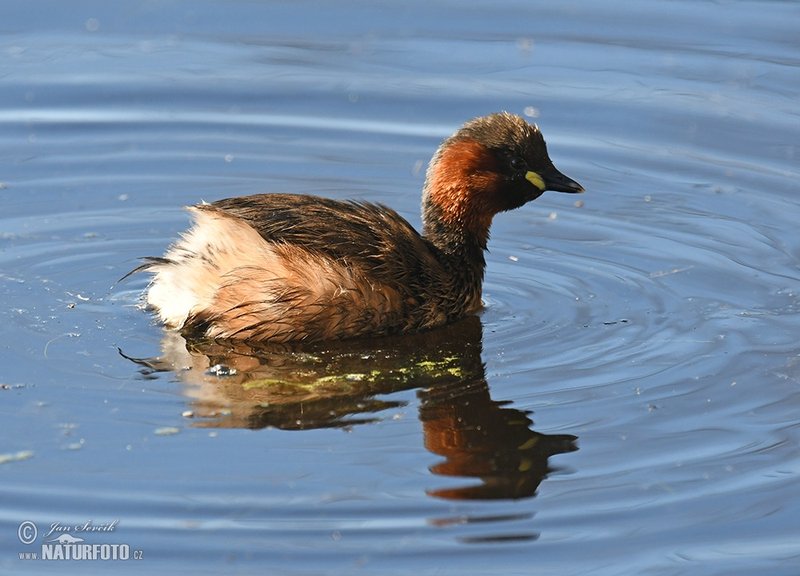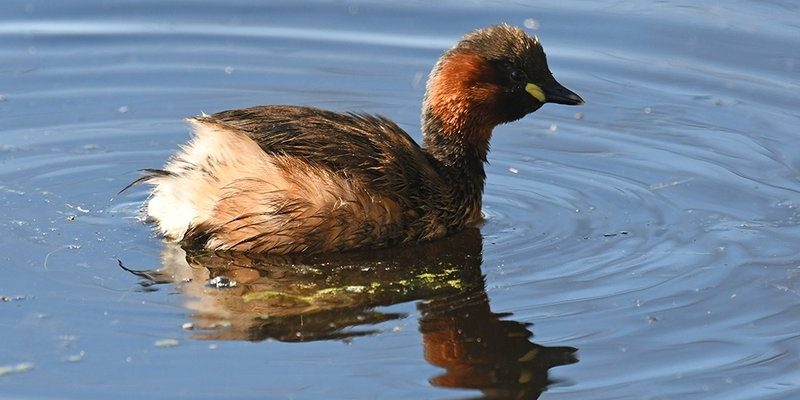
Imagine a tiny bird paddling gracefully across a serene pond, its small body barely breaking the glassy surface. That’s the Little Grebe, also known as the dabchick, a delightful little creature that brings charm and curiosity to any calm water body. With its compact frame and endearing demeanor, this bird manages to capture the hearts of birdwatchers and casual observers alike. If you’re looking to learn more about this fascinating species, you’ve come to the right place!
The Little Grebe is a small, water-loving bird that belongs to the family of grebes, which are known for their exceptional diving skills. These birds can often be seen performing an intriguing act called “diving,” where they swiftly submerge themselves to catch fish and other aquatic creatures. It’s a wonder to behold, especially when you realize how quickly they can disappear under the water and reappear elsewhere. After all, their agility is just one of the many reasons why they are such captivating subjects for nature lovers.
Physical Appearance
The Little Grebe is quite a sight to see! Typically, this bird measures about 12 to 15 inches in length, making it one of the smaller members of its family. Its plumage is a mix of rich chestnut and dark brown, which helps it blend seamlessly into its aquatic surroundings. You might notice a striking yellow patch on its cheeks during the breeding season, adding a splash of color to its otherwise understated look. In non-breeding seasons, however, this bird takes on a more muted appearance, which makes spotting one a delightful surprise.
One of the most notable features of the Little Grebe is its body shape. It has a stocky, compact figure, short neck, and a small head that sits on a relatively stout body. Its legs are positioned far back, which, while making walking on land quite a challenge, enables it to be an incredible swimmer. The way it propels itself through the water with quick, efficient strokes is nothing short of impressive. You might even see it diving underwater, disappearing from sight in a blink, which is all part of its charm.
Habitat and Distribution
Little Grebes are widespread across various regions, making their homes in freshwater lakes, ponds, marshes, and even slow-moving rivers. They prefer areas that have plenty of vegetation, like reeds and lily pads, which provide necessary hiding spots from predators. This love for calm, shallow waters allows them to hunt for food while feeling safe and secure.
When it comes to migration patterns, Little Grebes are somewhat unique. While some populations migrate seasonally, others stay put year-round, depending on their habitat’s conditions. In places where water bodies freeze, these birds are likely to migrate south to more temperate climates. You might find them across Europe, Asia, and Africa during certain times of the year. Isn’t it fascinating how different environments shape their behaviors and choices?
Diet and Feeding Behavior
The eating habits of the Little Grebe are quite eclectic. This bird primarily feeds on small fish, insects, and crustaceans, relying on its excellent diving abilities to catch its prey. When hunting, it takes a deep dive, sometimes going underwater for up to 30 seconds! Imagine holding your breath for that long while you search for a snack!
Interestingly, the feeding strategy of the Little Grebe can vary depending on the availability of food. In areas rich in aquatic insects, it may focus on catching those instead of fish. During the breeding season, these little birds often share their food with their chicks, showcasing a touching aspect of their parental care. You might see them bringing small fish back to the nest, which is a heartwarming sight for any birdwatcher.
Reproduction and Parenting
The breeding season for the Little Grebe is a time of excitement and activity. Mating rituals typically involve elaborate displays; males will perform a series of intricate dances to attract a mate. This often includes head-throwing and water-splashing, which makes for an entertaining show! Once a bond is established, these birds tend to form monogamous pairs for the breeding season.
Nesting usually takes place in dense vegetation near the water’s edge, where females construct nests using reeds and aquatic plants. They lay around 4 to 6 eggs, which are often spotted with brown or gray. Both parents take turns incubating the eggs, and once they hatch, the chicks are quick to join their parents in the water. It’s amazing to think about how these little ones learn to swim and dive just hours after hatching!
Table of Interesting Facts
| Common Name: | Little Grebe |
| Scientific Name: | Tachybaptus ruficollis |
| Length: | 12 – 15 inches |
| Wingspan: | 18 – 23 inches |
| Weight: | 10 – 15 ounces |
| Diet: | Fish, insects, crustaceans |
| Lifespan: | Up to 10 years |
| Habitat: | Freshwater lakes, marshes, ponds |
Behavior and Social Structure
When it comes to social behavior, Little Grebes are mostly solitary, although you might see them in small groups during the non-breeding season. They are quite territorial during the breeding season, aggressively defending their chosen nesting areas against intruders. This can lead to some fierce displays as they confront other birds that dare to come too close.
Despite their sometimes solitary nature, these birds are excellent communicators. They have a variety of vocalizations, from soft whistles to louder calls, which they use to communicate with each other, especially during the breeding season. You might be surprised at how diverse their sounds can be—it’s like they have their own secret language! Also, in addition to vocal communication, they often use body language, such as head movements, to convey their feelings.
Conservation Status
As charming as they are, the Little Grebe faces certain threats in the wild. Habitat loss due to urban development and pollution is a significant concern. Many natural wetlands are drained for agricultural or industrial purposes, leading to a decrease in suitable living areas for these birds. Additionally, changes in water quality can impact their food sources, making survival a challenge.
Fortunately, various conservation efforts are in place to help protect the Little Grebe and its habitats. Many organizations focus on preserving wetland areas, ensuring that these beautiful birds have a safe space to thrive. By raising awareness and promoting eco-friendly practices, we can help create a future where the Little Grebe continues to paddle gracefully across our waters.
FAQ
What is the best time to observe Little Grebes?
If you’re eager to spot these lovely birds, the best time to observe Little Grebes is during the breeding season, which typically runs from late spring to early summer. During this time, male grebes are especially active in displaying their courtship behaviors, making them more visible. Early mornings or late afternoons when they are most active can be ideal for sightings.
Can Little Grebes fly?
Yes, Little Grebes can fly, although they are primarily adapted for life on the water. They have relatively short wings compared to other bird species, which makes flight a bit cumbersome. Nevertheless, they can take off quickly from water when they feel threatened, so they are not completely grounded when it comes to flying!
Are Little Grebes good swimmers?
Absolutely! Little Grebes are excellent swimmers. With their streamlined bodies and webbed feet, they can glide through the water efficiently and dive expertly to catch fish and other prey. Their swimming abilities are one of the reasons they are such fascinating birds to watch in their natural habitats.
Do Little Grebes migrate?
Some populations of Little Grebes migrate seasonally, while others remain in the same general area year-round. Migration typically depends on the availability of food and the temperature of their habitats. In colder regions, you might find them migrating south to avoid frozen bodies of water.
How can I help protect Little Grebes?
There are a few ways you can help protect Little Grebes and their habitats. Supporting conservation organizations dedicated to preserving wetlands is a great start. Additionally, you can practice responsible birdwatching by keeping a safe distance and minimizing disturbance to their natural environments. Finally, spreading awareness about the importance of wetlands can inspire others to take action, too!
What do Little Grebe chicks look like?
When they first hatch, Little Grebe chicks are covered in fluffy down feathers, making them irresistibly cute! They are often striped with brown and white, which helps them camouflage in their surroundings. These chicks can swim shortly after hatching, and they often ride on their parents’ backs to stay safe from predators while learning to navigate their watery home.
Are Little Grebes social birds?
While Little Grebes tend to be more solitary, they can be seen in small groups, especially during the non-breeding season. They are territorial during breeding, and males will defend their nesting areas against intruders. Their vocalizations and body language play key roles in their social interactions.
What is the lifespan of a Little Grebe?
The lifespan of a Little Grebe can reach up to 10 years in the wild, though this can vary based on environmental conditions and threats they face. Factors like habitat loss, predation, and food availability can influence their survival rates. Protecting their habitats is essential for ensuring they can reach their full potential lifespan.
Can Little Grebes cause harm to their ecosystems?
No, Little Grebes are generally not harmful to their ecosystems. As part of the food chain, they help regulate fish and insect populations, contributing to the balance of their aquatic environments. Like many species, they play an essential role in maintaining healthy ecosystems, so their presence is beneficial rather than detrimental.
What challenges do Little Grebes face in urban areas?
In urban areas, Little Grebes face several challenges such as habitat destruction and pollution. Natural water bodies may be altered or eliminated to make way for development, which limits their nesting and feeding options. Additionally, contaminants in the water can affect their health and food sources, making it crucial to protect and restore wetlands wherever possible.

